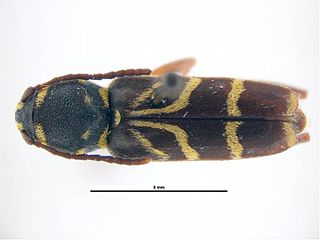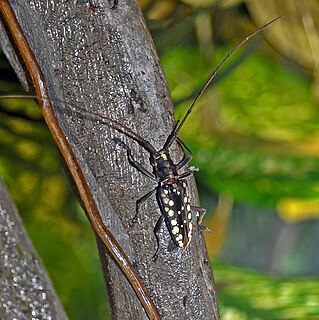
The longhorn beetles (Cerambycidae), also known as long-horned or longicorns, are a large family of beetles, with over 35,000 species described. Most species are characterized by extremely long antennae, which are often as long as or longer than the beetle's body. In various members of the family, however, the antennae are quite short and such species can be difficult to distinguish from related beetle families such as the Chrysomelidae. The scientific name of this beetle family goes back to a figure from Greek mythology: after an argument with nymphs, the shepherd Cerambus was transformed into a large beetle with horns.

Sphaerites is a genus of beetles, the only genus in the family Sphaeritidae, sometimes called the false clown beetles. It is closely related to the clown beetles but with distinct characteristics. There are five known species, widespread in temperate area but not commonly seen.

The Prioninae are a subfamily of Cerambycidae. They are typically large (25–70 mm) and usually brown or black. The males of a few genera sport large mandibles that are used in fights with other males, similar to stag beetles. These beetles are commonly nocturnal and are attracted to light. The majority of the Prioninae whose biology is known are borers whose larvae feed on rotting wood or roots.

Euryoryzomys nitidus, also known as the elegant oryzomys or elegant rice rat, is a rodent species in the family Cricetidae. Previously it was known as Oryzomys nitidus, but it is not closely related to Oryzomys as that genus is now constructed. Its range includes Bolivia, Brazil and Peru to the east of the Andes, in lowland tropical rainforest as well as forest in the eastern foothills of the mountains, at elevations from 50 to 2,000 m.

Phymatodes is a genus of beetles in the family Cerambycidae, containing the following species:
Haplidus is a genus of beetles in the family Cerambycidae, containing the following species:

Dorcacerus barbatus is a species of beetle in the family Cerambycidae, the only species in the genus Dorcacerus.

Retrachydes thoracicus is a species of beetle in the family Cerambycidae, the only species in the genus Retrachydes.

Andraegoidus cruentatus is a species of beetle in the family Cerambycidae. It was described by Dupont in 1838.

Neoeutrypanus is a genus of beetles in the family Cerambycidae containing the following species:

Xylotrechus nitidus is a species of beetle in the family Cerambycidae. It was described by Horn in 1860.
Haplidus nitidus is a species of beetle in the family Cerambycidae. It was described by Chemsak and Linsley in 1963.
Neoeutrypanus nitidus is a species of beetle in the family Cerambycidae. It was described by White in 1855.
Mimexocentroides nitidus is a species of beetle in the family Cerambycidae, and the only species in the genus Mimexocentroides. It was described by Breuning in 1961.
Leptocyrtinus nitidus is a species of beetle in the family Cerambycidae. It was described by Per Olof Christopher Aurivillius in 1926 and is known from Samoa.
Epepeotes nitidus is a species of beetle in the family Cerambycidae. It was described by Per Olof Christopher Aurivillius in 1923, originally under the genus Diochares. It is known from Sulawesi.
Hammatoderus nitidus is a species of beetle in the family Cerambycidae. It was described by Henry Walter Bates in 1874. It is known from Nicaragua.

Taeniotes farinosus is a species of beetle in the family Cerambycidae. It was described by Carl Linnaeus in 1758, originally under the genus Cerambyx.
Tmesisternus nitidus is a species of beetle in the family Cerambycidae. It was described by Gressitt in 1984.
Zographus nitidus is a species of beetle in the family Cerambycidae. It was described by Per Olof Christopher Aurivillius in 1914, originally Quimalanca. It is known from Uganda and the Democratic Republic of the Congo.











